Leonard Rodway was an English-born Australian dentist and botanist.

Ozothamnus is a genus of plants found in Australia, New Zealand and New Caledonia.

Ozothamnus diosmifolius is an erect, woody shrub in the family Asteraceae and is endemic to eastern Australia. Common names for this species include rice flower, white dogwood, pill flower and sago bush. It has dense heads of small white "flowers" and is often used in floral arrangements.
Ozothamnus × expansifolius is a species of Ozothamnus. It is a small pine-like plant, it has flowers that are white or reddish-brown, and the fruit achene grows on it. The plant's habitat is on mountain slopes and heaths at altitudes of 900-1200m. It can tolerate snowfalls and it can adapt to semi-shaded or sunny places. It is a hybrid of O. ledifolius and O. hookeri. The common name of the plant is crowded-leaf everlasting.

Ozothamnus ferrugineus, commonly known as tree everlasting, is a member of the genus Ozothamnus, of the Asteraceae family - one of the largest families of flowering plants in Australia. Native to the Australian states of New South Wales, Victoria, South Australia, and Tasmania, it forms an erect shrub or small tree between 2 and 3 metres in height.
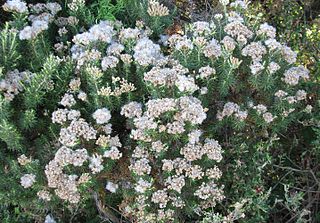
Ozothamnus turbinatus, the coast everlasting, is a shrub in the family Asteraceae, native to the states of New South Wales, Victoria, South Australia and Tasmania in Australia. It grows to between 1 and 2 metres in height.

Ozothamnus obcordatus, the grey everlasting, is a shrub in the family Asteraceae, native to the states of Queensland, New South Wales, Victoria and Tasmania in Australia.

Ozothamnus secundiflorus, the cascade everlasting, is an aromatic shrub species, endemic to Australia. It grows to between 0.5 and 2 metres in height. Leaves are 6 to 10 mm long and 1.5 to 4 mm wide. These are dark green with grey hairs on the upper surface, and white tomentose below. The white flower heads appear in dense clusters along one side of the stem between December and February in the species' native range.
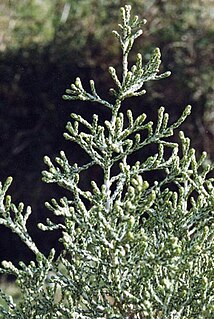
Ozothamnus hookeri, commonly known as kerosene bush, is an aromatic shrub species, endemic to Australia. It grows to between 0.5 and 1 metre in height and has white-tomentose branchlets. The scale-like leaves are 4 to 5 mm long and 0.5 to 1 mm wide. These are green on the upper surface, and white tomentose below. The flower heads appear in dense clusters in summer and autumn The species occurs in boggy sites and subalpine heathland New South Wales and Tasmania.

Ozothamnus cupressoides is an aromatic shrub species, endemic to Australia. Common names include scaly everlasting, lattice everlasting or kerosene bush. It grows to between 0.5 and 1 metre in height and has white-tomentose branchlets. The scale-like leaves are 1 to 3 mm long and 0.5 to 1 mm wide. These are green on the upper surface, and white tomentose below. The flower heads appear in dense clusters in summer and autumn The species occurs in boggy sites and subalpine heathland in New South Wales and Victoria. It was first formally described in 2010 in the journal Muelleria.
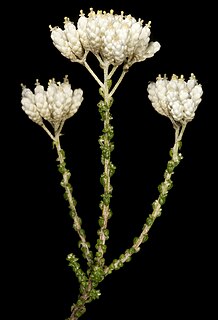
Ozothamnus lepidophyllus is a shrub in the family Asteraceae, native to Western Australia. It is erect, growing from 0.25 to 0.6 m high with white flowers and grows on loamy, sandy and rocky soils.

Ozothamnus alpinus, commonly known as alpine everlasting, is a flowering plant in the family Asteraceae. It is endemic to alpine and subalpine areas in south-eastern continental Australia.

Ozothamnus leptophyllus, commonly known as tauhinu or cottonwood, is an endemic shrub of New Zealand. Tauhinu is fast-growing, reaching 2 metres in height and is a common plant of coastal farmland. This species is host to the larvae of the New Zealand endemic moth Homoeosoma anaspila.
Ozothamnus thyrsoideus, commonly known as sticky everlasting, is a flowering shrub, endemic to south-eastern Australia. It grows to between 0.5 and 2 metres in height. Leaves are 15 to 30 mm long and 1.5 to 2 mm wide. Flowerheads appear in terminal corymbs in the summer.
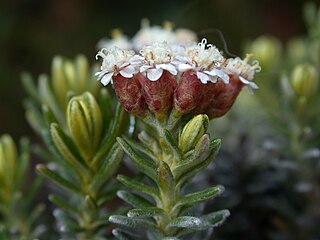
Ozothamnus ledifolius is a shrub, from the family Asteraceae and one of 54 species from the genus Ozothamnus. Harold Frederick Comber (1897–1969), an English horticulturist and plant collector, introduced Ozothamnus ledifolius in 1929 on mountains of Tasmania above 2500 ft. high from the seeds collected from 4000 ft. height.
Castiarina insculpta, the Miena jewel beetle, is a species of beetle in the jewel beetle family, Buprestidae. It is endemic to Tasmania, where it feeds on the asteraceous shrub Ozothamnus hookeri.
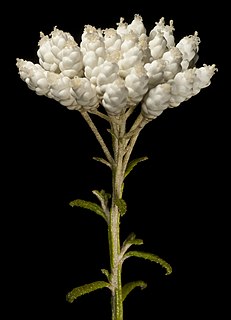
Ozothamnus occidentalis is a shrub in the family Asteraceae, native to Western Australia.
Ozothamnus tesselatus, commonly known as tesselate everlasting, is a flowering plant in the family Asteraceae. It is a small shrub with woolly branches and globular heads of whitish to straw-coloured flowers.

Ozothamnus rodwayi, commonly known as alpine everlastingbush, is a species of flowering plant in the family Asteraceae that is endemic to Tasmania, Australia. Its is a widespread small, dense alpine shrub abundantly found in alpine and high subalpine heaths and woodlands.
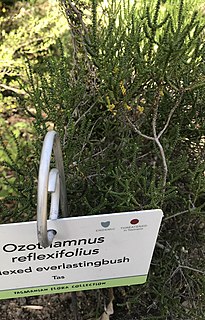
Ozothamnus reflexifolius, commonly known as reflexed everlastingbush, is a flowering plant in the family Asteraceae. It is known from only a single population in the Meehan Range, south-eastern Tasmania. It is thought to be closely related to O. lycopodioides and O. selaginoides.















